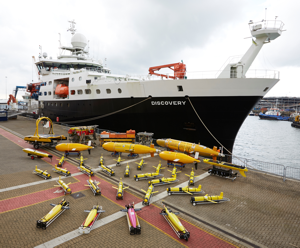Marine Autonomous and Robotic Systems - Gliders

The NOC has gliders from two manufacturers in our fleet, Slocum gliders from Teledyne Webb Research Corporation, and Seagliders from iRobot. These vehicles undertake research in coastal waters to the deep ocean. Shallow water versions of the Slocums are based at our Liverpool laboratory, and have carried out missions in Liverpool Bay and the Irish Sea. The deep-water vehicles are based at Southampton.
Why do we use gliders?
We use gliders because they are a very effective tool for gathering data from the oceans and we can direct where they travel over a two-way satellite communications (Iridium) link. They use little energy, and so are inexpensive to operate. Gliders have very low-power consumption sensors, typically only needing an average power of 700mW.
In addition, although buoyancy change engines are not necessarily as efficient as a motor and propeller, the fact that gliders travel very slowly means they consume little energy to propel themselves. A Slocum glider capable of diving to 1,000 metres, when it reaches the bottom, consumes about 65 Watts from its batteries, for about two minutes, to pump the oil to the external bladder. It does not have to do that again until perhaps three hours later when it is back down deep.
There is a down side of course. If the measurements we want to make would take a great deal of power, for example to map the seabed with complex sonar, the instrument would be too large and too power hungry for a glider. That is where we would use an Autosub. Or, if we need to make measurements at speed, current gliders just do not travel fast enough. In the future, both of these limitations may ease, because researchers are working on combining the best features of a glider with those of propeller-driven vehicles.